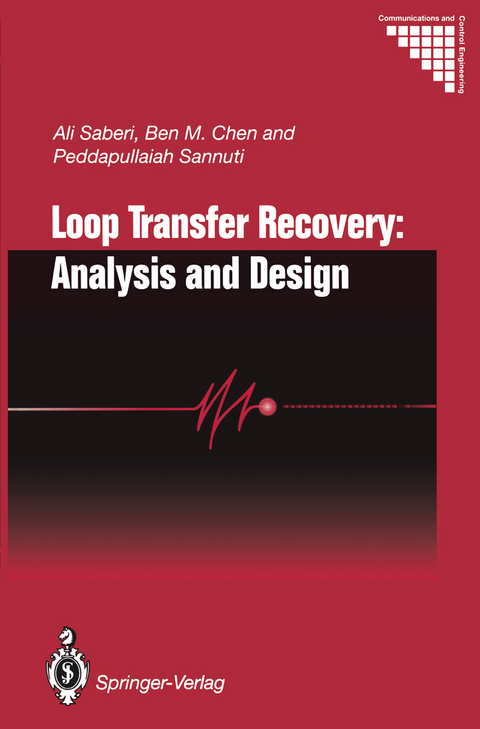
Loop Transfer Recovery: Analysis and Design
Springer London Ltd (Verlag)
978-1-4471-3224-0 (ISBN)
Loop Transfer Recovery (LTR) is part of the Communications and Control Engineering Series (CCES) edited by Professors B.W. Dickinson, E.D. Sontag, M. Thoma, A. Fettweis, J.L. Massey and J.W. Modestino. Loop Transfer Recovery deals with several issues of analysis and design of the Loop Transfer Recovery (LTR) problem. It discusses when and how an LTR is possible and outlines different controller structures and the available design freedom. An explanation of the actual design methods for accomplishing an LTR is given. Besides dealing with observer based measurement feedback controllers, which are commonly used for LTR, a new controller with a different architecture which out performs observer based controllers is presented. This publication will be of benefit to anyone who has completed a first graduate course in linear systems and state-space methods, together with an elementary knowledge of Linear Quadratic Control.
1 Introduction.- 1.1 Introduction.- 1.2 Problem formulation.- 1.3 Preliminaries.- 2 Preliminary Analysis of Continuous LTR.- 2.1 Introduction.- 2.2 Preliminary analysis.- 2.A Proof of Lemma 2.2.1.- 2.B Proof of Proposition 2.2.2.- 3 Continuous LTR — Detailed Analysis.- 3.1 Introduction.- 3.2 Recovery analysis while not using the knowledge of F.- 3.3 Analysis for recoverable target loop transfer functions.- 3.4 Recovery analysis in a given subspace.- 3.5 Duality of LTRI and LTRO.- 3.A Proof of Lemma 3.2.1.- 3.B Proof of Lemma 3.2.2.- 3.C Proof of Proposition 3.2.2.- 3.D Proof of Lemma 3.2.3.- 3.E Proof of Corollary 3.3.2.- 3.F Proof of Lemma 3.4.2.- 3.G Proof of Lemma 3.4.3.- 4 Continuous LTR — Design.- 4.1 Introduction.- 4.2 Design constraints and the available freedom.- 4.3 ATEA design method.- 4.4 Optimization based design methods.- 4.5 Design for recovery over a specified subspace.- 4.6 LTR design for output break point.- 4.7 Comparison of ATEA and optimization based design algorithms.- 4.A Proof of Theorem 4.3.1.- 4.B Proof of Theorem 4.3.2.- 4.C Proof of Theorem 4.4.2.- 5 Introduction to Discrete LTR.- 5.1 Introduction.- 5.2 Problem formulation.- 5.3 Preliminaries.- 6 Preliminary Analysis of Discrete LTR.- 6.1 Introduction.- 6.2 Controller structures for discrete LTR.- 6.3 Preliminary analysis.- 6.A Proof of Proposition 6.3.1.- 7 Discrete LTR — Detailed Analysis.- 7.1 Introduction.- 7.2 Recovery analysis while not using the knowledge of F.- 7.3 Analysis for recoverable target loop transfer functions.- 7.4 Recovery analysis in a given subspace.- 7.5 Duality of LTRI and LTRO.- 7.A Proof of Lemma 7.2.2.- 7.B Proof of Corollary 7.3.1.- 7.C Proof of Theorem 7.4.4.- 8 Discrete LTR — Design.- 8.1 Introduction.- 8.2 Design constraints and the available freedom.-8.3 Design by eigenstructure assignment.- 8.4 Optimization based design methods.- 8.5 Design for recovery over a specified subspace.- 8.6 LTR design for output break point.- 8.A Proof of Theorem 8.4.1.- 9 Closed-Loop Transfer Recovery.- 9.1 Introduction.- 9.2 Continuous CLTR.- 9.3 Discrete CLTR.- 9.A Proof of Lemma 9.2.1.- 10 Some Issues of Controller Architecture.- 10.1 Introduction.- 10.2 Recoverability with an arbitrarily structured controller.- 10.3 CSS architecture based controllers for LTR.- 10.4 Design examples.- 10.5 Open research problems.- 10.A Proof of Theorem 10 2 1.- 10.B Proof of Lemma 10.3.1.- 10.C Proof of Theorem 10 3 1.
| Erscheint lt. Verlag | 1.12.2011 |
|---|---|
| Reihe/Serie | Communications and Control Engineering |
| Zusatzinfo | XIII, 352 p. |
| Verlagsort | England |
| Sprache | englisch |
| Maße | 155 x 235 mm |
| Themenwelt | Mathematik / Informatik ► Informatik ► Theorie / Studium |
| Naturwissenschaften ► Chemie ► Technische Chemie | |
| Technik ► Elektrotechnik / Energietechnik | |
| Technik ► Maschinenbau | |
| ISBN-10 | 1-4471-3224-6 / 1447132246 |
| ISBN-13 | 978-1-4471-3224-0 / 9781447132240 |
| Zustand | Neuware |
| Haben Sie eine Frage zum Produkt? |
aus dem Bereich


